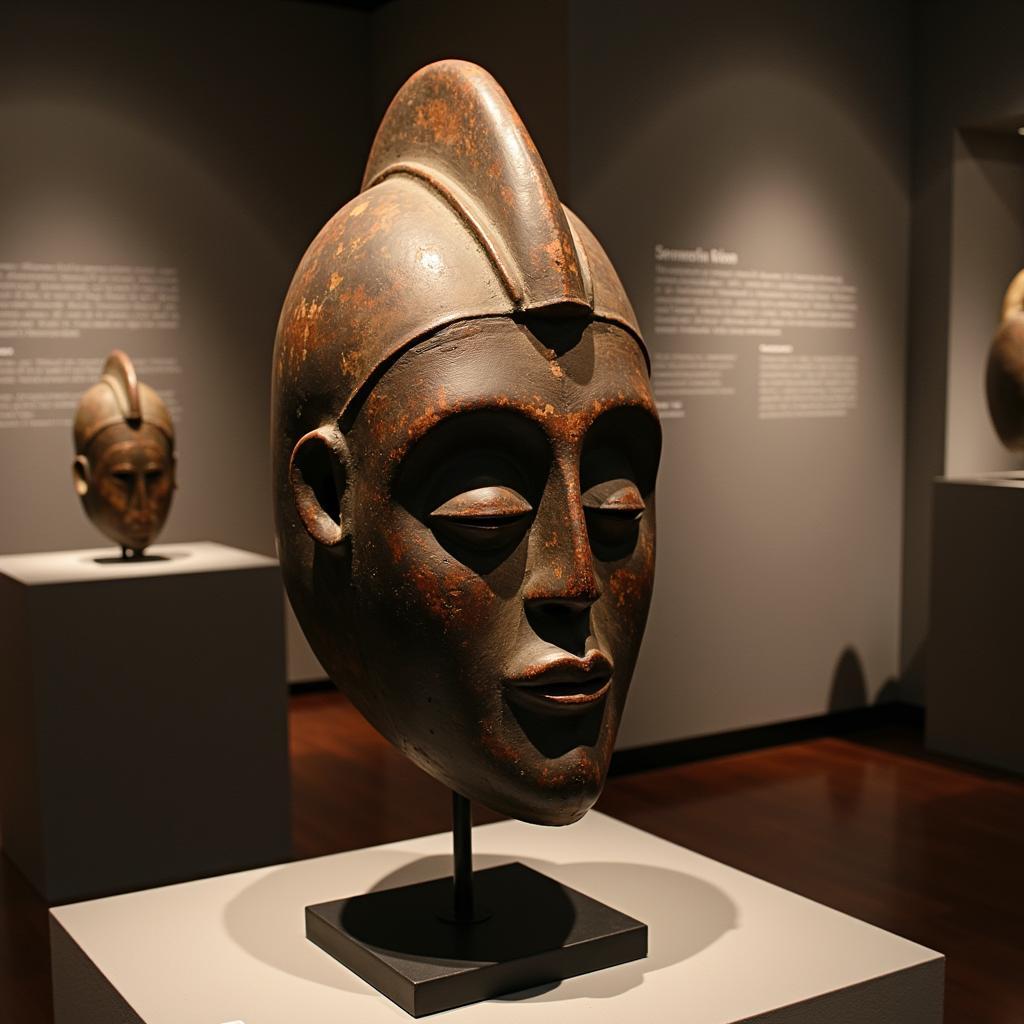Unveiling the Mysteries of the African Helmet Mask
African Helmet Masks, striking and enigmatic, hold a significant place in African art and culture. These sculpted head coverings, often adorned with intricate details, represent more than mere aesthetics; they embody spiritual power, social status, and a deep connection to ancestral realms. From their diverse forms to their ceremonial roles, we’ll delve into the captivating world of African helmet masks.
A Diverse Tapestry: Exploring the Many Forms of African Helmet Masks
African helmet masks, far from a monolithic entity, boast remarkable diversity. Their forms vary significantly depending on the ethnic group, region, and intended purpose. Some masks represent animals, harnessing the symbolic power of the natural world. Others portray ancestors, serving as a tangible link to the past. Still others embody spirits, mediating between the human and supernatural realms. This diversity is reflected in the materials used, ranging from wood and fiber to metal and feathers, and in the artistic styles employed, from abstract geometric patterns to highly realistic depictions. For example, the masks of the Mende people of Sierra Leone often feature a high, smooth forehead symbolizing wisdom and composure, while the masks of the Igbo people of Nigeria may incorporate horns or elaborate headdresses to denote power and prestige.
Beyond the Surface: Understanding the Symbolism of African Helmet Masks
The symbolism embedded within African helmet masks is as rich and varied as their forms. Animals represented in masks often embody specific traits: the lion might symbolize strength and courage, the elephant wisdom and patience, the bird freedom and spirituality. Ancestral masks serve as a conduit to the wisdom and guidance of past generations. Spirit masks, on the other hand, can represent benevolent deities or powerful forces of nature. These masks are not simply representations; they are believed to embody the very essence of what they depict.
The Role of African Helmet Masks in Ceremony and Ritual
African helmet masks are integral to a wide array of ceremonies and rituals, including initiation rites, funerals, festivals, and agricultural ceremonies. They are often worn by dancers who, through their movements and gestures, bring the masks to life, embodying the spirits or ancestors they represent. In some cultures, the wearer of the mask enters a trance-like state, becoming a vessel for the spirit world to communicate with the human world. These ceremonies are not mere performances; they are vital expressions of cultural identity and spiritual belief. For instance, the Dogon people of Mali utilize masks in dama ceremonies, intricate funerary rituals meant to guide the souls of the deceased into the afterlife.
What are the common materials used in crafting African helmet masks?
Common materials include wood, fibers, metal, feathers, and pigments.
How are African helmet masks used in contemporary art?
Contemporary artists draw inspiration from traditional forms, incorporating them into modern sculptures, paintings, and mixed-media works. These artists explore themes of identity, heritage, and the ongoing dialogue between tradition and modernity.
African Helmet Masks: A Legacy of Artistic Expression
 African Helmet Mask Displayed in a Museum
African Helmet Mask Displayed in a Museum
African helmet masks, though originating from ancient traditions, continue to inspire and captivate audiences worldwide. They are not relics of the past but living expressions of artistic ingenuity and spiritual depth. From museums and galleries to private collections, these masks serve as powerful reminders of Africa’s rich cultural heritage. They are a testament to the enduring power of art to connect us to the past, present, and future.
In conclusion, African helmet masks are more than just beautiful objects; they are portals to a world of complex beliefs, rituals, and artistic expression. Exploring their various forms, symbolism, and ceremonial uses offers a glimpse into the heart of African culture. By understanding the significance of these masks, we can appreciate the depth and richness of human creativity and spirituality. If you are interested in learning more about African art, you should also take a look at african folk art masks.
FAQ
-
What are the main functions of African helmet masks?
They serve ceremonial, ritualistic, and artistic purposes, often representing spirits, ancestors, or animals. -
How can I identify the origin of a specific African helmet mask?
Style, materials, and iconography often point to specific ethnic groups or regions. -
Are African helmet masks still used in ceremonies today?
Yes, many communities continue to use masks in traditional ceremonies and rituals. -
What is the significance of the colors used in African helmet masks?
Colors often hold symbolic meaning, relating to specific spirits, elements, or social statuses. -
Where can I see African helmet masks in person?
Museums, art galleries, and cultural centers often house collections of African masks.
Scenarios
- Scenario 1: A student researching African art for a school project wants to understand the symbolism of different animal representations in helmet masks.
- Scenario 2: A museum curator is preparing an exhibition on African masks and needs information on the ceremonial context of helmet masks.
- Scenario 3: An art collector is interested in acquiring an African helmet mask and wants to learn more about their cultural significance and authenticity.
Further Exploration
- Research specific ethnic groups known for their unique helmet mask traditions.
- Explore the role of music and dance in ceremonies involving African masks.
- Investigate the impact of colonialism on African art and mask-making.
For further assistance, please contact us at Phone Number: +255768904061, Email: [email protected], or visit our address: Mbarali DC Mawindi, Kangaga, Tanzania. Our customer service team is available 24/7.